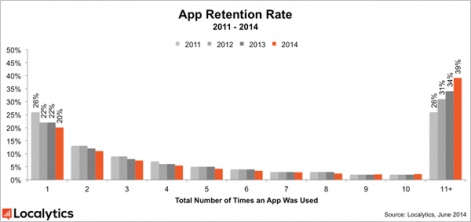Mark Rosner is Chief Publishing Officer of AppLovin.
Of all the metrics developers scrutinize, the most important metric that they need to monitor and optimize against might be retention.
Because two thirds of mobile gamers quit after just one day maximizing the number of returning players has immeasurable benefits.
Take casinos. They want to keep players playing for as long as possible, so they retain players by giving them free drinks, perks and entertainment. They focus on the quality of the experience to retain players and in turn maximize the money they make off each player.
Similarly, retention is something all game developers need to track and focus on as they improve the quality of their games. There are methodical tactics to boost your game's retention.
The benefits of retention
Retention - essentially the stickiness of your game - could make or break your chances at success. The obvious benefit of retention is that the longer players stay in the game, the longer they engage and the more you earn. But beyond that, there are byproducts to having a game with great retention.
Retention can help with organic growth and word-of-mouth. If your players keep playing, then they are more likely to talk about your game and refer friends.
Optimizing for retention forces you to focus on improving the product and qualityMark Rosner
Optimizing for retention also forces you to focus on improving the product and quality, because you need to give your players a good experience and keep them coming back to play.
The result? A positive feedback loop: your high quality game retains players, who recruit more players, who earn you money, which encourages you to optimize your game, which means you generate more players who engage for longer.
Need an example? We've all heard of Candy Crush, and there's a reason for that. Candy Crush is the Gold Standard for retention.
When a player comes into the game, she gets a tutorial for every level. The game hooks the player, guides her through and encourages her to play more. What happens in those first few minutes is extremely crucial.
Games like Candy Crush know that retention for mobile is particularly important because user acquisition costs are so high in this competitive space. The more you can retain your players and keep them engaging and talking about your game, the easier it is to see a better return on acquisition spend.
Setup and measuring retention
At the very beginning of your development, think of optimizing for retention. Make sure you set up tracking before your game is launched and consider how levels or specific points in your game can be used to get players to play more.
Map out how you are tracking retention. Retention is typically measured at set points in time in intervals of 1, 3, 7, 14, or 30 days. Additionally, a more sophisticated developer might even look at event cohorts within these time frames.

By doing so, you can break players up by cohorts based on events or achievements and use this to better understand where they might drop off, get stuck or even how easy or difficult a certain task may be. Taking the time to measure retention and focusing on improving it is critical to your success. Use analytics platforms that allow for cohort analysis and dashboards that show trends in retention like Mixpanel, Amplitude, Adjust or Tune.
Quality game, ongoing content
Make sure your game is technically stable; the one thing that spells death for your retention efforts is the specter of technical instability.
Players have an incredibly low tolerance for things like games that crash, so you must stay focused on delivering a high quality experience or risk heavy drop-off at times of technical difficulties or on devices where your game crashes.
Even when your game is launched, your job isn't over. Come up with new content, new levels, daily challenges and game loops to keep players coming back. Notifying players of this new content and interacting with them when they are out of the game is crucial. Push notifications are a powerful way to get players back to your game, so follow best practices and use them to get players to engage.
Retarget to get players back
Another way to reach players when they are outside of your game is to utilize retargeting ads. Use ads in other similar games to get your players back to yours.
And make sure you advertise new content or levels and then deep-link to bring them back to that specific content.
AppLovin's Chief Publishing Officer, Mark Rosner is charged with the growth of all supply channels, inclusive of publisher and exchange relationships.
He is committed to making sure that AppLovin has the supply to execute on its mission of pairing advertisers with people.
While Mark began his career on Wall Street, the appeal of all things mobile brought him to Zedge, where he served as both CRO and CEO, steering the company towards a dominant position within the mobile customization category with 50 million monthly uniques.
Now with AppLovin from its birth as a demand source, Mark believes that the power of ad tech personalization trumps all and informs what he does at AppLovin every day.





















